Logistics and forwarding companies say the situation is resembling a milder version of the supply chain crisis seen during the worst of the pandemic.
Asia’s cargo deliveries and supply chain have been thrown into uncertainty during the peak holiday season following Houthi militant attacks on ships plying the Red Sea, which connects to the arterial route to Europe through the Suez Canal.
Shipping lines, led by the world’s second-largest container shipping company AP Moller-Maersk, have since last weekend suspended vessels on the route, which accounts for around 15 per cent of the world’s shipping traffic and 30 per cent of global container traffic.
Houthi militants have attacked 10 vessels, saying they are targeting those with a connection to Israel, which is locked in a war with Hamas. The rebels have also been launching drones and missiles against Israel, more than 1,000 miles (1,600km) away.
Ships have been forced to divert around the Cape of Good Hope, adding up to two weeks’ journey, or 30-40 per cent more time between Asia and Europe, said Cedomir Nestrovic, professor of geopolitics at Singapore’s ESSEC Business School Asia-Pacific.
“Import costs will be higher for perishable food items with limited shelf lives like cheese, butter and salmon as well as beverages like wine,” he said. Exports of electronics and automobile parts to Europe from Asia are also likely to stumble because of the shipping bottleneck, he said.
The upheaval in freight structures may also usher in supply-chain shifts to certain parts of Asia from others, he added.
‘Prices are soaring’: Red Sea attacks push up China-Europe container rates
The militant attacks have exacerbated traffic on the Suez Canal, where low water levels due to a drought in the region have reduced the number of vessels that can pass through on the route since around July-August.
Logistics and forwarding companies have painted a bleak picture for the impact on shipping, saying the situation is resembling a milder version of the supply chain crisis seen during the worst of the pandemic.
Start
United States
USA — mix Red Sea attacks threaten Asia’s holiday food imports, rattle supply chains: ‘stakes...






